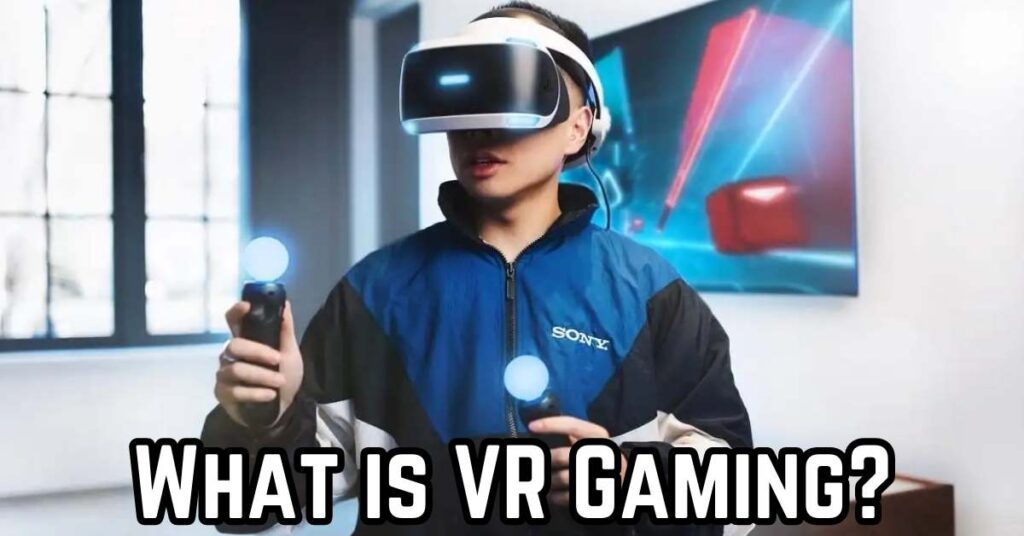In the realm of modern technology, virtual reality (VR) has emerged as a groundbreaking innovation that has revolutionized the way we experience entertainment and gaming. Among its various applications, VR gaming stands out as a remarkable fusion of cutting-edge technology and immersive gameplay.
With the ability to transport players into virtual worlds, VR gaming has become a captivating experience that blurs the lines between reality and fantasy. In this blog post, we will delve into the history, evolution, and mechanics of VR gaming, shedding light on the fascinating world that captivates players worldwide.
A Journey Through Time: Early VR Games (1980s-2000s)
The roots of VR gaming trace back to the late 1980s when visionaries like Jaron Lanier and Thomas G. Zimmerman began experimenting with virtual reality hardware. Their pioneering work led to the development of devices like the VPL DataGlove, a revolutionary glove that could translate finger movements into computer input. The emergence of the Power Glove, a more affordable version of the DataGlove, marked an important step in making VR accessible to the public.
Interest in VR surged in the 1990s, propelled by the film “Lawnmower Man,” which introduced the concept of VR headsets to mainstream audiences. Nintendo’s Virtual Boy and Sega’s VR device, despite their shortcomings, laid the foundation for future VR endeavors. The Cave Automatic Virtual Environment (CAVE) systems also made their debut, showcasing the potential of immersive environments but remaining cost-prohibitive.
Fast forward to the late 2000s, VR gaming continued to intrigue academics and researchers, but commercial adoption remained limited due to high hardware costs. Innovations in real-time 3D graphics during this era laid the groundwork for what was to come, as VR slowly but surely gained momentum.
Introduction of Consumer-Ready Hardware (2010s–present)
The dawn of the 2010s saw a significant shift in the VR landscape. The introduction of the Oculus Rift in 2016 marked a turning point, making consumer-grade VR hardware accessible to a wider audience. Developed by Palmer Luckey and later acquired by Facebook, the Oculus Rift brought immersive VR experiences within reach. Sony’s PlayStation VR and Valve’s HTC Vive soon followed suit, cementing VR gaming as a legitimate entertainment medium.
Additionally, mobile-driven VR experiences gained traction with devices like Google Cardboard and Samsung Gear VR, utilizing smartphones to create stereoscopic displays. Nintendo also joined the fray with its Labo VR Kit, providing a unique take on VR interaction for the Nintendo Switch.
Despite the technological advancements, VR gaming faced challenges in finding its “killer app,” a game that would serve as a catalyst for widespread adoption. This changed with the release of Half-Life: Alyx in 2020. Developed by Valve, Alyx showcased innovative control schemes and overcame motion sickness issues, leading to increased sales of VR hardware.
How VR Gaming Works?
VR gaming’s core components include the VR headset, positional tracking, and input devices. The VR headset offers stereoscopic displays that immerse players in three-dimensional environments, while positional tracking technology monitors the player’s movement within the virtual space. This tracking can be achieved through built-in sensors, external cameras, or other methods.
Player input is a crucial aspect of VR gaming, often facilitated by specialized controllers. These controllers provide haptic feedback, enhancing immersion by simulating touch sensations. VR games are typically played from a first-person perspective, utilizing the player’s physical movements to dictate in-game actions.
Designing VR games requires careful consideration of immersion and presence. Ensuring minimal latency between a player’s actions and the feedback they receive is essential for maintaining the feeling of being within the virtual world. Technological advancements in graphics rendering and sensor technology have significantly improved this aspect, allowing for more seamless experiences.
Do you know that Baldur’s Gate 3 has emerged as a breathtaking spectacle in the gaming world, demonstrating its magnificent visuals and complex gameplay mechanics? With an initial encounter involving the eerie skin of a Mindflayer and the disquieting implantation of a parasitic worm into one’s eye, players are immediately immersed in a vivid, nightmare-like environment:
Venturing Beyond the Pixels: The Wide-Ranging Impacts of VR Across Various Sectors
As the virtual reality (VR) landscape continues to evolve, its influence resonates far beyond the captivating realm of gaming, reaching into a tapestry of industries and applications that redefine the boundaries of possibility. The immersive potential of VR transcends the confines of entertainment, extending its tendrils into realms as diverse as education, healthcare, training, art, and beyond. This expansion of VR’s scope not only enriches experiences but also reshapes how we perceive and interact with the world around us.
Within the realm of education, VR has emerged as an invaluable tool, offering students immersive journeys that bring historical events to life, explore the wonders of the natural world, and even transport them to distant planets. With VR, the dusty pages of textbooks transform into vibrant, experiential lessons that foster deeper understanding and engagement. Students can stroll through ancient civilizations, witness scientific phenomena firsthand, and navigate complex concepts through interactive simulations. This immersive approach to education holds the potential to revolutionize traditional learning methods, inspiring curiosity and fostering a lifelong love of discovery.
The healthcare sector, too, has embraced VR as a transformative force. Medical professionals harness VR to simulate surgeries, offering surgeons the opportunity to practice intricate procedures in a risk-free environment. Patients find solace in VR’s ability to transport them from sterile hospital rooms to serene landscapes, alleviating pain and anxiety. VR therapy has shown promise in treating various mental health conditions, guiding individuals through immersive experiences that promote relaxation and healing. The fusion of VR technology with healthcare not only enhances medical practices but also empowers patients to take control of their well-being.
In the world of professional training, VR emerges as an invaluable tool for honing skills and simulating real-world scenarios. Industries spanning aviation, manufacturing, and emergency response rely on VR to offer immersive training experiences that prepare individuals for high-stakes situations without the associated risks. Flight simulators provide pilots with a lifelike cockpit experience, while firefighters navigate hazardous environments in virtual flames. This approach to training not only enhances competence but also safeguards lives by ensuring individuals are equipped to handle challenges with confidence.
Art and creativity find new dimensions within the realm of VR. Artists harness its immersive canvas to craft intricate 3D sculptures, paint in mid-air with virtual brushes, and invite audiences into immersive installations that transcend the boundaries of traditional media. VR allows for the exploration of interactive narratives, where viewers become active participants within the story, influencing its course and outcomes. This fusion of technology and art fosters an era of boundless creativity, where the imagination is unleashed within a realm without limitations.
Beyond these applications, the expansion of VR is a testament to human innovation, highlighting our capacity to mold technology to suit a diverse array of needs. As VR continues to mature, its influence ripples across industries, reimagining the way we work, learn, heal, and create. With each new development, the boundary between the digital and physical worlds blurs further, leading us into an era where the possibilities are limited only by our imagination.
New Era in Virtual Reality: Immersion Beyond the Ordinary
In the boundless expanse of virtual reality, a new era has dawned, where the fusion of technology and human imagination has given birth to an immersive realm that transcends the confines of the ordinary. As we reflect on the journey through the captivating world of VR gaming and its far-reaching impacts, it becomes clear that we stand at the precipice of a new paradigm that has forever changed how we interact with both digital realms and the world around us.
From its humble beginnings in the late 20th century to the modern-day marvels that grace our living rooms, VR gaming has evolved from a concept to a thriving reality. It’s a testament to the relentless pursuit of innovation, to the audacious visionaries who dared to dream beyond what was considered possible. The journey, marked by devices like the VPL DataGlove and the Oculus Rift, has led us to an era where the digital and physical worlds converge in unprecedented ways.
VR gaming is not just an entertainment medium; it’s an invitation to explore uncharted territories, to challenge the limits of our imagination, and to partake in experiences that were once confined to the realms of fiction. As the pixels and polygons transport us to galaxies far, far away, or into the heart of ancient civilizations, we find ourselves not as mere observers, but as active participants in the stories that unfold before us.
But the allure of VR extends beyond entertainment. It’s a catalyst for transformation in education, revolutionizing the way we learn and understand complex concepts. It’s a source of healing in healthcare, where virtual realms provide solace to patients and training grounds for medical professionals. It’s a tool of empowerment in training, equipping individuals to face challenges with competence born from simulated experience. It’s a canvas for artists to explore new dimensions, pushing the boundaries of creativity to unimaginable heights.
As we marvel at the seamless blend of technology and human ingenuity, it’s evident that the journey of VR gaming is far from over. The path ahead is illuminated by the possibilities that emerge as technology evolves, barriers are shattered, and creators continue to push the envelope. With each stride forward, the line between reality and the virtual blurs further, and the notion of what’s achievable becomes ever more expansive.
In the grand tapestry of innovation, VR gaming stands as a thread that weaves together the aspirations of generations. It embodies the spirit of exploration, the pursuit of excellence, and the dedication to shaping a future that defies convention. The immersive experiences it offers are not just fleeting moments of escapism; they are windows into a universe of creativity, curiosity, and connection.
Conclusion
As we draw the curtains on this exploration of VR gaming, one thing is certain: we are witnesses to a transformative force that touches our lives in ways we could have scarcely imagined. It’s an invitation to step beyond the boundaries of the known, embrace the unknown, and redefine what it means to be part of a world where pixels and dreams converge. The journey continues, and the realms of VR, with all their wonder and potential, beckon us to dive deeper, explore further, and imagine beyond the limits of our reality.

